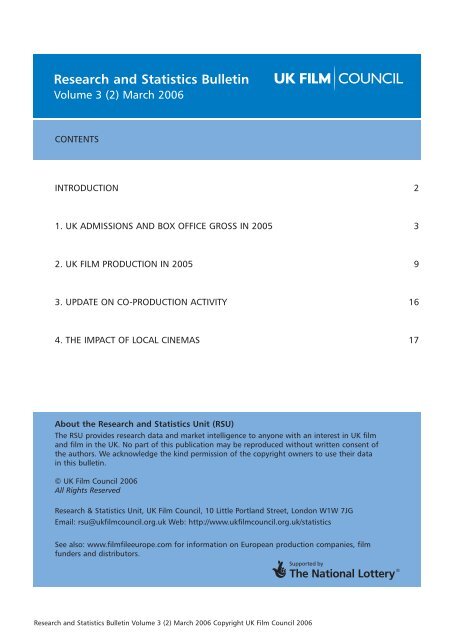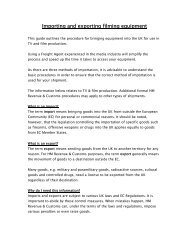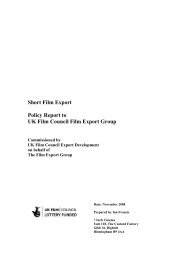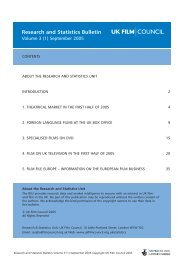Research and Statistics Bulletin - BFI - British Film Institute
Research and Statistics Bulletin - BFI - British Film Institute
Research and Statistics Bulletin - BFI - British Film Institute
Create successful ePaper yourself
Turn your PDF publications into a flip-book with our unique Google optimized e-Paper software.
<strong>Research</strong> <strong>and</strong> <strong>Statistics</strong> <strong>Bulletin</strong><br />
Volume 3 (2) March 2006<br />
CONTENTS<br />
INTRODUCTION 2<br />
1. UK ADMISSIONS AND BOX OFFICE GROSS IN 2005 3<br />
2. UK FILM PRODUCTION IN 2005 9<br />
3. UPDATE ON CO-PRODUCTION ACTIVITY 16<br />
4. THE IMPACT OF LOCAL CINEMAS 17<br />
About the <strong>Research</strong> <strong>and</strong> <strong>Statistics</strong> Unit (RSU)<br />
The RSU provides research data <strong>and</strong> market intelligence to anyone with an interest in UK film<br />
<strong>and</strong> film in the UK. No part of this publication may be reproduced without written consent of<br />
the authors. We acknowledge the kind permission of the copyright owners to use their data<br />
in this bulletin.<br />
© UK <strong>Film</strong> Council 2006<br />
All Rights Reserved<br />
<strong>Research</strong> & <strong>Statistics</strong> Unit, UK <strong>Film</strong> Council, 10 Little Portl<strong>and</strong> Street, London W1W 7JG<br />
Email: rsu@ukfilmcouncil.org.uk Web: http://www.ukfilmcouncil.org.uk/statistics<br />
See also: www.filmfileeurope.com for information on European production companies, film<br />
funders <strong>and</strong> distributors.<br />
<strong>Research</strong> <strong>and</strong> <strong>Statistics</strong> <strong>Bulletin</strong> Volume 3 (2) March 2006 Copyright UK <strong>Film</strong> Council 2006
Introduction<br />
2005 - a year of mixed fortunes<br />
Cinema admissions finished the year strongly, but overall were 3.8% down on 2004<br />
<strong>and</strong> 6.4% down on the peak year of 2002. On the other h<strong>and</strong>, this was a much better<br />
performance than in a number of European territories, which saw admission declines of<br />
10-20% compared with 2004. UK box office revenues were the same as in 2004 according<br />
to Nielsen EDI.<br />
Factors holding back admissions <strong>and</strong> box office growth included: the underperformance<br />
of some of the films released by the US majors, greater availability of film on DVD <strong>and</strong> the<br />
impact of on-line <strong>and</strong> DVD piracy, which the industry estimates could cost it several hundred<br />
million pounds per year.<br />
One reason the UK box office performed relatively better than in some European territories<br />
was the extremely good performance of UK films in 2005. UK films took 34% of the box<br />
office, compared to 23% the previous year. <strong>Film</strong>s contributing to this record included:<br />
Harry Potter <strong>and</strong> the Goblet of Fire, Charlie <strong>and</strong> the Chocolate Factory, Wallace & Gromit:<br />
The Curse of the Were-Rabbit, Nanny McPhee, Batman Begins, Pride <strong>and</strong> Prejudice <strong>and</strong><br />
The Hitchhiker’s Guide to the Galaxy.<br />
On the production side (section 2 of this bulletin), 2005 saw a significant fall in inward<br />
investment volumes <strong>and</strong> co-production activity, but a growth in the numbers <strong>and</strong> value<br />
of domestic UK films. Inward investment – particularly incoming US studio film production –<br />
was affected by uncertainty over the tax regime prior to the Government’s December 5 2005<br />
tax announcement, the lower value of the US dollar relative to Sterling (making production<br />
in the USA more competitive) <strong>and</strong> competition from newly emerging production<br />
destinations.<br />
The pattern of co-production activity is illuminated further in section 3, summarising official<br />
co-production certifications by the Department for Culture, Media <strong>and</strong> Sport. From relatively<br />
low levels in the late 1990s, co-production activity accelerated to a peak in 2003/2004, since<br />
then it has eased back in response to tighter certification rules <strong>and</strong> uncertainty over future<br />
tax incentives.<br />
While the tax situation has now been settled, it is unlikely that co-productions will return<br />
to the 2003/04 peak as, in future, tax incentives will be calculated on the basis of UK spend,<br />
rather than total budget, which will discourage low UK spend co-productions that might<br />
otherwise have been constructed to gain access to UK tax incentives.<br />
Finally, in section 4, we look at a good news story for the UK exhibition sector – the positive<br />
social, economic <strong>and</strong> cultural impacts of local cinemas. Based on a study funded by the UK<br />
<strong>Film</strong> Council, the <strong>British</strong> <strong>Film</strong> <strong>Institute</strong>, EM Media <strong>and</strong> <strong>Film</strong> London between 2002 <strong>and</strong> 2005,<br />
this section reports a range of positive social benefits arising from smaller cinemas in town<br />
centre locations – a sense of place, a broadening of film choice, social inclusion, educational<br />
<strong>Research</strong> <strong>and</strong> <strong>Statistics</strong> <strong>Bulletin</strong> Volume 3 (2) March 2006 Copyright UK <strong>Film</strong> Council 2006<br />
2
<strong>and</strong> volunteering opportunities, improved local safety, vibrancy of town centres, architectural<br />
conservation <strong>and</strong> economic impacts such as increased spending for nearby businesses,<br />
dem<strong>and</strong> for local supplies <strong>and</strong> increased employment.<br />
Examining these impacts is part of a broader UK <strong>Film</strong> Council research programme looking at<br />
the social, economic <strong>and</strong> cultural impacts of film in the context of the public value delivered<br />
by Government support of the UK film industry <strong>and</strong> film culture, the results of which will be<br />
published as they emerge.<br />
David Steele, Head of <strong>Research</strong> <strong>and</strong> <strong>Statistics</strong> Unit (RSU)<br />
Sean Perkins, <strong>Research</strong> Executive<br />
March 1 2006<br />
About the UK <strong>Film</strong> Council<br />
The UK <strong>Film</strong> Council was established by the Government in 2000 as the lead agency for film<br />
in the UK ensuring that the economic, cultural <strong>and</strong> educational aspects of film are effectively<br />
represented at home <strong>and</strong> abroad.<br />
We support:<br />
• Creativity - encouraging the development of new talent, skills <strong>and</strong> creative <strong>and</strong><br />
technological innovation in UK film, <strong>and</strong> assisting new <strong>and</strong> established filmmakers<br />
to produce successful <strong>and</strong> distinctive <strong>British</strong> films.<br />
• Enterprise - supporting the creation <strong>and</strong> growth of sustainable businesses in the film<br />
sector, providing access to finance <strong>and</strong> helping the UK film industry compete successfully<br />
in the domestic <strong>and</strong> global marketplace.<br />
• Imagination - promoting education <strong>and</strong> an appreciation <strong>and</strong> enjoyment of cinema by<br />
giving UK audiences access to the widest range of UK <strong>and</strong> international cinema, <strong>and</strong><br />
by supporting film culture <strong>and</strong> heritage.<br />
1. UK admissions <strong>and</strong> box office gross in 2005<br />
Although admissions declined 3.8% year on year to 165 million in 2005, the UK theatrical<br />
market performed better than most other major territories last year. The strong boost in the<br />
final quarter of the year offset the relatively poor returns in the summer months which were<br />
characterised by under-performing blockbusters. The increase in year end admissions can be<br />
attributed to the strong performance of UK films such as Harry Potter <strong>and</strong> the Goblet of Fire<br />
<strong>and</strong> Wallace & Gromit: The Curse of the Were-Rabbit as well as films based on familiar UK<br />
story material such as The Chronicles of Narnia: the Lion, the Witch <strong>and</strong> the Wardrobe.<br />
As a result of these high profile releases, average weekly admissions rose to 4 million in<br />
December – the highest since July 2004. The monthly breakdown is given in tables 1.1 to 1.3.<br />
<strong>Research</strong> <strong>and</strong> <strong>Statistics</strong> <strong>Bulletin</strong> Volume 3 (2) March 2006 Copyright UK <strong>Film</strong> Council 2006<br />
3
Table 1.1 Monthly admissions, 2005<br />
Month 2004 (m) 2005 (m) % +/- on 2004<br />
January 15.3 13.4 -12.4<br />
February 13.3 14.8 +11.3<br />
March 10.7 12.3 +15.0<br />
April 14.5 10.6 -26.9<br />
May 13.1 13.1 0<br />
June 14.7 10.5 -28.6<br />
July 18.4 16.0 -13.0<br />
August 17.4 15.9 -8.6<br />
September 10.2 9.5 -6.9<br />
October 14.5 15.6 +7.6<br />
November 14.6 15.2 +4.1<br />
December 14.6 17.6 +20.5<br />
Total 171.3 164.7 -3.8<br />
Source: CAA, Nielsen EDI<br />
Table 1.2 Average weekly admissions, 2005<br />
Month 2004 weekly<br />
average (m)<br />
Source: CAA, Nielsen EDI<br />
2005 weekly<br />
average (m)<br />
January 3.5 3.0<br />
February 3.2 3.7<br />
March 2.4 2.8<br />
April 3.4 2.5<br />
May 3.0 3.0<br />
June 3.4 2.5<br />
July 4.2 3.6<br />
August 3.9 3.6<br />
September 2.4 2.2<br />
October 3.3 3.5<br />
November 3.4 3.5<br />
December 3.3 4.0<br />
<strong>Research</strong> <strong>and</strong> <strong>Statistics</strong> <strong>Bulletin</strong> Volume 3 (2) March 2006 Copyright UK <strong>Film</strong> Council 2006<br />
4
Table 1.3 Monthly admissions, 2001-2005<br />
Month 2001 (m) 2002 (m) 2003 (m) 2004 (m) 2005 (m)<br />
January 11.6 15.0 16.3 15.3 13.4<br />
February 13.8 19.0 15.0 13.3 14.8<br />
March 10.0 14.3 10.4 10.7 12.3<br />
April 14.0 13.2 12.4 14.5 10.6<br />
May 11.6 14.0 13.8 13.1 13.1<br />
June 9.4 12.2 9.4 14.7 10.5<br />
July 13.8 15.0 12.4 18.4 16.0<br />
August 18.1 15.9 17.1 17.4 15.9<br />
September 10.6 10.6 10.7 10.2 9.5<br />
October 13.4 13.4 17.3 14.5 15.6<br />
November 14.7 16.5 13.7 14.6 15.2<br />
December 14.8 16.9 18.8 14.6 17.6<br />
Total 155.8 176.0 167.3 171.3 164.5<br />
Source: CAA, Nielsen EDI<br />
The pattern of regional admissions remains largely unchanged from the previous year<br />
(Table 1.4). The London, Midl<strong>and</strong>s <strong>and</strong> Lancashire TV regions typically account for half<br />
of all UK admissions (having high urban population densities).<br />
<strong>Research</strong> <strong>and</strong> <strong>Statistics</strong> <strong>Bulletin</strong> Volume 3 (2) March 2006 Copyright UK <strong>Film</strong> Council 2006<br />
5
Table 1.4 Cinema admissions by TV region, 2005<br />
Region Admimssions %<br />
London 41,332,225 25.1<br />
Midl<strong>and</strong>s 23,280,583 14.1<br />
Lancashire 18,264,672 11.1<br />
Southern 15,244,349 9.3<br />
Yorkshire 13,771,042 8.4<br />
Central Scotl<strong>and</strong> 11,343,353 6.9<br />
East Of Engl<strong>and</strong> 10,896,998 6.6<br />
Wales & West 10,788,202 6.6<br />
North East 6,343,985 3.9<br />
Northern Irel<strong>and</strong> 4,920,551 3.0<br />
South West 3,616,164 2.2<br />
Northern Scotl<strong>and</strong> 3,275,036 2.0<br />
Border 1,614,618 1.0<br />
Total 164,691,778 100.0<br />
Source: CAA/Nielsen EDI<br />
Whilst 2005 saw a decline in cinema admissions, the total box office gross for the UK <strong>and</strong><br />
Irel<strong>and</strong> increased by 1% to £840,352,231. The UK box office remained stable at £770m.<br />
Table 1.5 lists the top 20 performers by box office gross in 2005. Eight UK titles feature in<br />
a top 20 dominated by family-oriented fantasy films: Harry Potter <strong>and</strong> the Goblet of Fire;<br />
Charlie <strong>and</strong> the Chocolate Factory; Wallace & Gromit: The Curse of the Were-Rabbit; Nanny<br />
McPhee; Batman Begins; Pride <strong>and</strong> Prejudice; The Hitchhiker’s Guide to the Galaxy <strong>and</strong><br />
Valiant. Together with the first film in The Chronicles of Narnia series, titles based on UK<br />
story material played exceptionally well to local audiences. As in the previous two years,<br />
all the top 20 titles were made with some form of US involvement.<br />
<strong>Research</strong> <strong>and</strong> <strong>Statistics</strong> <strong>Bulletin</strong> Volume 3 (2) March 2006 Copyright UK <strong>Film</strong> Council 2006<br />
6
Table 1.5 Box office results for the top 20 films released in the UK, 2005<br />
Rank Title Country of<br />
origin<br />
1 Harry Potter <strong>and</strong> the<br />
Goblet of Fire*<br />
2 The Chronicles of<br />
Narnia: The Lion,<br />
the Witch <strong>and</strong> the<br />
Wardrobe*<br />
3 Star Wars: Episode III -<br />
Revenge of the Sith<br />
4 Charlie <strong>and</strong> the<br />
Chocolate Factory<br />
5 Wallace & Gromit:<br />
The Curse of the<br />
Were-Rabbit<br />
Box office<br />
gross (£m)<br />
Number of<br />
Opening<br />
cinemas<br />
Source: Nielsen EDI, RSU<br />
Box office gross = cumulative total up to 12 February 2006<br />
<strong>Film</strong>s with an asterisk (*) were still being exhibited on 12 February 2006<br />
<strong>Film</strong>s with double asterisk (**) are shown with weekend figures corresponding to the first weekend of wide release, rather than opening weekend.<br />
Table 1.6 focuses on the performance of top UK films at the box office. The total box office<br />
gross of the top 20 UK films was £244.05 million, compared with £176.18 million in 2004<br />
<strong>and</strong> £121.63 million in 2003. Seven inward investment titles, made in the UK with some<br />
<strong>Research</strong> <strong>and</strong> <strong>Statistics</strong> <strong>Bulletin</strong> Volume 3 (2) March 2006 Copyright UK <strong>Film</strong> Council 2006<br />
Opening<br />
weekend<br />
gross (£m)<br />
Distributor<br />
UK/USA 48.53 535 14.93 Warner Bros.<br />
USA/NZ 43.24 498 8.88 Buena Vista<br />
International<br />
USA 39.43 490 14.36 20th Century Fox<br />
UK/USA 37.46 531 7.97 Warner Bros.<br />
UK/USA 32.00 501 9.37 UIP<br />
6 War of the Worlds USA 30.65 507 8.64 UIP<br />
7 King Kong* USA/NZ 29.98 481 6.94 UIP<br />
8 Meet the Fockers USA 28.93 456 7.92 UIP<br />
9 Madagascar USA 22.65 505 5.43 UIP<br />
10 Hitch** USA 17.39 448 4.23 Sony<br />
11 Nanny McPhee UK/USA 16.49 427 2.60 UIP<br />
12 Batman Begins UK/USA 16.42 514 4.43 Warner Bros.<br />
13 Pride <strong>and</strong> Prejudice UK/USA 14.57 397 2.53 UIP<br />
14 Mr. & Mrs. Smith USA 13.59 450 3.94 20th Century Fox<br />
15 Wedding Crashers USA 13.16 409 2.18 Entertainment<br />
16 Fantastic Four USA 12.71 406 3.54 20th Century Fox<br />
17 Ocean’s Twelve USA 12.58 450 3.39 Warner Bros.<br />
18 Robots USA 12.48 474 2.62 20th Century Fox<br />
19 The Hitchhiker’s<br />
Guide to the Galaxy<br />
UK/USA 10.67 465 3.30 Buena Vista<br />
International<br />
20 Valiant UK/USA 8.52 403 1.10 Entertainment<br />
7
degree of US involvement, earned over £10 million at the UK box office. In addition, the<br />
number of domestic <strong>and</strong> co-productions earning between £3 million <strong>and</strong> £6 million (such as<br />
The Magic Roundabout, The Constant Gardener, Corpse Bride <strong>and</strong> Mrs Henderson Presents)<br />
contributed to a strong year for UK film at the box office.<br />
Table 1.6 Top 20 UK films released in the UK, 2005<br />
Rank Title Country of<br />
origin<br />
1 Harry Potter <strong>and</strong> the<br />
Goblet of Fire*<br />
2 Charlie <strong>and</strong> the<br />
Chocolate Factory<br />
3 Wallace <strong>and</strong> Gromit:<br />
The Curse of the<br />
Were-Rabbit<br />
Source: Nielsen EDI, RSU<br />
Box office gross = cumulative total up to 12 February 2006<br />
<strong>Film</strong>s with an asterisk (*) were still being exhibited on 12 February 2006<br />
Box office<br />
gross (£m)<br />
Distributor<br />
UK/USA 48.53 Warner Bros.<br />
UK/USA 37.46 Warner Bros.<br />
UK/USA 32.00 UIP<br />
4 Nanny McPhee UK/USA 16.49 UIP<br />
5 Batman Begins UK/USA 16.42 Warner Bros.<br />
6 Pride <strong>and</strong> Prejudice UK/USA 14.57 UIP<br />
7 The Hitchhiker’s<br />
Guide to the Galaxy<br />
UK/USA 10.67 Buena Vista<br />
International<br />
8 Valiant UK/USA 8.52 Entertainment<br />
9 Closer UK/USA 8.49 Sony<br />
10 Kingdom of Heaven UK/USA/Spa/Ger 7.77 20th Century Fox<br />
11 White Noise UK/Can/USA 6.46 Entertainment<br />
12 The Magic<br />
Roundabout<br />
13 The Constant<br />
Gardener*<br />
UK/Fra 5.96 Pathé<br />
UK 5.33 UIP<br />
14 Corpse Bride UK/USA 4.85 Warner Bros.<br />
15 Sahara UK/USA/Spa/Ger 4.83 UIP<br />
16 The Wedding Date UK/USA 3.96 Entertainment<br />
17 Mrs. Henderson<br />
Presents*<br />
UK 3.43 Pathé<br />
18 Kinky Boots UK/USA 3.03 Buena Vista<br />
International<br />
19 Alex<strong>and</strong>er UK/USA/Fra/Neth 2.73 Warner Bros.<br />
20 The Descent UK 2.72 Pathé<br />
<strong>Research</strong> <strong>and</strong> <strong>Statistics</strong> <strong>Bulletin</strong> Volume 3 (2) March 2006 Copyright UK <strong>Film</strong> Council 2006<br />
8
2. UK <strong>Film</strong> production in 2005<br />
2.1 The value of UK production, 2005<br />
UK production activity fell to £569 million in 2005 from £812m in 2004 <strong>and</strong> 2003’s<br />
particularly high level of £1,158 million.<br />
There were 25 inward investment productions in 2005, with a UK production value of<br />
£312 million. (See Table 2.1 for definitions). Big budget films contributing to this figure<br />
were: The Da Vinci Code, Basic Instinct 2, V for Vendetta <strong>and</strong> The Children of Men.<br />
The high international visibility of these titles illustrates the continuing importance of UK<br />
film production in the global film industry.<br />
There were 37 domestic features in 2005 to a value of £166 million, a significant increase<br />
on 2004. Larger budget films contributing to this total included: Sunshine, Stormbreaker,<br />
Breaking <strong>and</strong> Entering <strong>and</strong> Flight 93.<br />
UK co-productions (other than inward) fell from 86 to 62, with UK spend dropping from<br />
£146 million to £91 million, in part reflecting a tightening in certification requirements.<br />
UK co-productions in 2005 included: The Queen, Love <strong>and</strong> Other Disasters, The Last King<br />
of Scotl<strong>and</strong> <strong>and</strong> The Wind That Shakes the Barley.<br />
Production levels in 2005 were affected by uncertainty over future tax incentives for film,<br />
prior to the Government’s announcement of the new system on 5 December 2005. Levels<br />
of inward investment were additionally affected by the low value of the US dollar relative<br />
to Sterling in 2005, which made film production in the USA relatively more competitive, <strong>and</strong><br />
the competitiveness of newly emerging alternative production destinations.<br />
Table 2.1 Feature film production activity, 2004-2005<br />
Number of<br />
Productions<br />
2004<br />
Value £m<br />
2004<br />
Source: UK <strong>Film</strong> Council International<br />
Definitions<br />
1. An inward feature is defined as a feature film more than 50% financed from outside the UK where the production is location non-specific or is<br />
attracted to the UK because of its infrastructure<br />
2. An inward feature co-production is an official co-production that originates from outside the co-production treaty countries (usually from the USA)<br />
<strong>Research</strong> <strong>and</strong> <strong>Statistics</strong> <strong>Bulletin</strong> Volume 3 (2) March 2006 Copyright UK <strong>Film</strong> Council 2006<br />
Number of<br />
Productions<br />
2005<br />
Value £m<br />
2005<br />
Inward feature films (single country) 17 476.9 19 240.8<br />
Inward feature films (co-productions) 3 71.6 6 71.2<br />
Total inward investment 20 548.5 25 312.0<br />
Domestic UK feature films 27 117.8 37 166.3<br />
UK co-productions (other than inward) 86 145.6 62 90.5<br />
Total production investment 133 811.9 124 568.8<br />
9
<strong>and</strong> which is attracted to the UK because of its infrastructure.<br />
3. A domestic UK feature is a feature made by a UK production company that is shot wholly or partly in the UK.<br />
4. A UK co-production is a co-production (other than an inward co-production) involving the UK <strong>and</strong> other country partners under the terms of<br />
a bilateral co-production agreement or the European Co-production Convention.<br />
Measurement<br />
5. The total budget is counted for all productions which are likely to qualify as <strong>British</strong> under Schedule 1 of the <strong>Film</strong>s Act 1985.<br />
6. Only UK spend is counted for co-productions.<br />
7. Spend is allocated to the year in which principal photography started.<br />
Exclusions<br />
8. The provision of UK production <strong>and</strong> post-production services to films other than those counted in Table 2.1 is not included.<br />
9. Spending on films with budgets under £500,000 is not included.<br />
2.2 Inward, domestic <strong>and</strong> UK co-production features 1992-2005<br />
Figure 2.1 puts the 2005 figures in a longer time perspective. The decline in domestic<br />
features since 1997 has occurred alongside a substantial growth in co-production activity,<br />
suggesting it has been easier to make films as official co-productions than as st<strong>and</strong>-alone<br />
UK productions. With the change in tax rules, commencing in 2006, we may see a stronger<br />
growth in domestic productions compared to co-productions in the future. Despite a lower<br />
production value in 2005, the number of inward features shows a thirteen year upward<br />
trend. Despite a small overall fall compared with 2004, production numbers overall<br />
continued at a high level in 2005 compared with the low levels of the early 1990s, before<br />
the introduction of tax relief <strong>and</strong> Lottery support for UK film.<br />
Figure 2.1 Number of inward, domestic<br />
<strong>and</strong> UK co-production features, 1992-2005<br />
Number of features<br />
100<br />
80<br />
60<br />
40<br />
20<br />
0<br />
2005<br />
2004<br />
2003<br />
2002<br />
2001<br />
2000<br />
1999<br />
1998<br />
1997<br />
1996<br />
1995<br />
1994<br />
1993<br />
1992<br />
Source: UK <strong>Film</strong> Council International<br />
Note: ‘Inward features’ includes inward investment co-productions from 2002<br />
Inward features<br />
Domestic UK features<br />
UK co-pros<br />
The value of UK production in 2005 was significantly lower than in 2003 <strong>and</strong> 2004,<br />
returning to the levels of 2000 <strong>and</strong> 2002. (Figure 2.2). Since 1997, the fluctuation in<br />
production value has principally been driven by inward features. However the value of<br />
domestic <strong>and</strong> UK co-productions also slipped in the last two years, reflecting uncertainties<br />
in the funding environment.<br />
<strong>Research</strong> <strong>and</strong> <strong>Statistics</strong> <strong>Bulletin</strong> Volume 3 (2) March 2006 Copyright UK <strong>Film</strong> Council 2006<br />
10
Figure 2.2 Value of inward, domestic, UK<br />
co-production <strong>and</strong> total features, 1992-2005<br />
Value of production (£million)<br />
1200<br />
1000<br />
800<br />
600<br />
400<br />
200<br />
0<br />
1993<br />
1992<br />
Source: UK <strong>Film</strong> Council International<br />
Notes: ‘Inward features’ includes inward investment co-productions from 2002.<br />
For co-productions (inward <strong>and</strong> UK) only the UK spend is included in the above chart (not the total budget).<br />
2.3 Budgets ease back<br />
In 2005, budgets for individual films shot partly or wholly in the UK decreased. The falls<br />
were particularly notable for inward features, measured both by median <strong>and</strong> average<br />
budgets. The only budget measure which increased (slightly) was the average for domestic<br />
UK productions, which went up from £4.4m to £4.5m, reflecting a number of higher budget<br />
domestic films such as Stormbreaker, Sunshine <strong>and</strong> Flight 93.<br />
Table 2.2 Comparison of median <strong>and</strong> average budgets, 2003-2005<br />
Production category Median budget £m<br />
2003 2004 2005<br />
Source: UK <strong>Film</strong> Council International, RSU analysis<br />
Notes:<br />
‘Average budget’ is the arithmetical mean (ie total budget divided by total number of films in the category, for which budgets were available).<br />
‘Median budget’ is the middle value (ie there are equal numbers of films above <strong>and</strong> below the median budget).<br />
Where the average is higher than the median (as it is with all the categories in Table 2.2) this indicates that the average has been skewed upwards<br />
by a relatively small number of high budget films.<br />
<strong>Research</strong> <strong>and</strong> <strong>Statistics</strong> <strong>Bulletin</strong> Volume 3 (2) March 2006 Copyright UK <strong>Film</strong> Council 2006<br />
Average budget £m<br />
2003 2004 2005<br />
Inward features (single country) 12.1 16.5 12.8 26.5 36.0 20.1<br />
Inward features<br />
(co-productions)<br />
1995<br />
1994<br />
46.6 38.1 33.6 51.6 47.4 30.7<br />
Domestic UK productions 3.0 2.9 2.3 6.1 4.4 4.5<br />
Co-productions<br />
(other than inward)<br />
2005<br />
2004<br />
2003<br />
2002<br />
2001<br />
2000<br />
1999<br />
1998<br />
1997<br />
1996<br />
Inward features<br />
Domestic UK features<br />
UK co-pros<br />
Total production value<br />
3.5 4.4 4.3 5.5 5.4 4.6<br />
11
2.4 Size distribution of budgets, 2005<br />
The size distribution of the budgets for the four categories of film is shown in Tables 2.3<br />
to 2.6. Four features with budgets of over £30 million accounted for 59.4% of the aggregate<br />
budget for inward features (single country). Nine out of 19 features had budgets of less than<br />
£10 million.<br />
Table 2.3 Size distribution of budgets, inward features (single country), 2005<br />
Budget b<strong>and</strong> (£m) Number Total budget in<br />
b<strong>and</strong> (£m)<br />
Source: UK <strong>Film</strong> Council International, RSU analysis<br />
Four inward features (co-productions) had budgets of £30 million or more. Two had budgets<br />
in the £10-30 million range <strong>and</strong> none had budgets under £10 million.<br />
Table 2.4 Size distribution of budgets, inward features (co-productions), 2005<br />
Source: UK <strong>Film</strong> Council International, RSU analysis<br />
As in 2004, there were no domestic UK features in 2005 with budgets over £30 million.<br />
Most domestic UK features had budgets under £5 million, though the ten films in the<br />
£5-30 million budget range accounted for two thirds of the combined budget.<br />
Table 2.5 Size distribution of budgets, domestic UK features, 2005<br />
Source: UK <strong>Film</strong> Council International, RSU analysis<br />
% of total budget<br />
£30m+ 4 214.5 59.4<br />
£10-30m 6 115.8 32.1<br />
Under £10m 9 31.0 8.6<br />
Total 19 361.3 100.0<br />
Budget b<strong>and</strong> (£m) Number Total budget in<br />
b<strong>and</strong> (£m)<br />
% of total budget<br />
£30m+ 4 149.2 81.0<br />
£10-30m 2 35.1 19.0<br />
Under £10m 0 0.0 0.0<br />
Total 6 184.3 100.0<br />
Budget b<strong>and</strong><br />
(£m)<br />
Number Total budget in<br />
b<strong>and</strong> (£m)<br />
% of total budget<br />
£30m+ 0 0.0 0.0<br />
£10-30m 3 58.5 35.2<br />
£5-10m 7 52.9 31.8<br />
£2-5m 15 42.7 25.7<br />
£0.5-2m 12 12.3 7.4<br />
Total 37 166.4 100.0<br />
<strong>Research</strong> <strong>and</strong> <strong>Statistics</strong> <strong>Bulletin</strong> Volume 3 (2) March 2006 Copyright UK <strong>Film</strong> Council 2006<br />
12
Most co-productions (other than inward) were in the budget range £2-10 million (44 out<br />
of 62) accounting for 84% of the combined budget. Compared with 2004, there were fewer<br />
films, <strong>and</strong> a lower budget share, in the £10-30 million budget range.<br />
Table 2.6 Size distribution of budgets, UK co-productions (other than inward), 2005<br />
Budget b<strong>and</strong> (£m) Number Total budget in<br />
b<strong>and</strong> (£m)<br />
Source: UK <strong>Film</strong> Council International, RSU analysis<br />
2.5 Big budget productions, 2002-2005<br />
The importance to UK spend of a small number of big budget productions – most of which<br />
are inward investment films – is demonstrated in Table 2.7. In 2005, the eight films with<br />
budgets of £30 million or more accounted for 63.9% of total UK production spend.<br />
Table 2.7 Big budget films’ contribution to UK spend, 2002-2005<br />
Budget b<strong>and</strong> (£m) 2002 2003 2004 2005<br />
Number of films with<br />
budgets more than £30m<br />
Value of associated<br />
UK spend<br />
Source: UK <strong>Film</strong> Council International, RSU analysis<br />
5 15 8 8<br />
196.6 671.6 432.4 363.7<br />
Total UK spend 550.5 1157.7 811.9 568.8<br />
Big budget film share<br />
of UK spend<br />
35.7% 58.0% 53.3% 63.9%<br />
2.6 UK share of expenditure<br />
Table 2.8 shows the UK expenditure shares for inward investment films, inward<br />
co-productions <strong>and</strong> co-productions (other than inward). Inward investment films had<br />
the highest UK expenditure share (66.6%). This is because most inward investment films<br />
qualified as <strong>British</strong> under Schedule 1 of the <strong>Film</strong>s Act 1985, which required a 70% UK<br />
spend for certification. Inward co-productions had a UK expenditure share of 38.6% <strong>and</strong><br />
co-productions (other than inward), 32.1%.<br />
<strong>Research</strong> <strong>and</strong> <strong>Statistics</strong> <strong>Bulletin</strong> Volume 3 (2) March 2006 Copyright UK <strong>Film</strong> Council 2006<br />
% of total budget<br />
£30m+ 0 0.0 0.0<br />
£10-£30m 2 23.7 8.4<br />
£5-10m 19 140.3 49.7<br />
£2-5m 25 96.6 34.2<br />
£0.5-2m 16 21.7 7.7<br />
Total 62 282.3 100.0<br />
13
Table 2.8 UK expenditure shares 2005<br />
Inward investment films 66.6%<br />
Inward co-productions 38.6%<br />
Co-productions<br />
(other than inward)<br />
Source: UK <strong>Film</strong> Council International, RSU analysis<br />
32.1%<br />
2.7 UK co-productions by country of shoot<br />
Table 2.9 shows the shoot locations for UK co-productions (not including inward investment)<br />
in 2005. The most frequent locations were the UK (15 productions) <strong>and</strong> Germany, Italy,<br />
Luxembourg, Romania <strong>and</strong> Spain with six each. Although the ranking is slightly different,<br />
these countries were also popular shoot locations in 2004. Canada (with two) <strong>and</strong> France<br />
(zero) were notably less popular in 2005 than in 2004, when they provided shoot locations<br />
for five <strong>and</strong> eight UK co-productions respectively. This reflects the lower amount of UK-<br />
Canada <strong>and</strong> UK-France co-production activity as efforts have been made to balance the<br />
number of majority Canadian <strong>and</strong> French co-productions with majority UK productions.<br />
Table 2.9 UK co-productions, country<br />
of shoot, 2005<br />
Country Number of<br />
productions<br />
UK 15<br />
Germany 6<br />
Italy 6<br />
Luxembourg 6<br />
Romania 6<br />
Spain 6<br />
Irel<strong>and</strong> 5<br />
Hungary 4<br />
Belguim 3<br />
Netherl<strong>and</strong>s 3<br />
Austria 2<br />
Canada 2<br />
Isle of Man 2<br />
Sweden 2<br />
USA 2<br />
Others 21<br />
Source: UK <strong>Film</strong> Council International<br />
Note: Some productions were shot in more than one country, hence the total in Table 2.9 is greater than the number of UK co-productions.<br />
<strong>Research</strong> <strong>and</strong> <strong>Statistics</strong> <strong>Bulletin</strong> Volume 3 (2) March 2006 Copyright UK <strong>Film</strong> Council 2006<br />
14
Table 2.10 shows the shoot locations by region for UK co-productions shot abroad between<br />
2003 <strong>and</strong> 2005. Western Europe (not including the UK) was once again the most frequent<br />
destination. Shoots in Eastern Europe <strong>and</strong> Russia (mainly Romania <strong>and</strong> Hungary) increased<br />
again, after dropping in 2004. Elsewhere, numbers were relatively small in 2005.<br />
Table 2.10 Location of shoot by region, UK co-productions shot abroad, 2003-2005<br />
Region Shot abroad in<br />
2003<br />
Source: UK <strong>Film</strong> Council International, RSU analysis<br />
Note: Of the co-productions in 2003 <strong>and</strong> 2004 for which location information was not available, some may have been shot in the UK.<br />
2.8 Production company activity levels<br />
UK film production in 2005 was, as usual, dispersed over a large number of production<br />
companies, as shown in Table 2.11. UK <strong>Film</strong> Council International recorded 263 production<br />
companies associated with films shot in the UK or co-productions involving the UK in 2005.<br />
Of these, 195 companies were associated with a single feature. A considerable number of<br />
these are likely to have been single-purpose vehicles. The two most prolific production<br />
companies were associated with seven features each, followed by two companies with four<br />
features, four with three features <strong>and</strong> seventeen with two features.<br />
Table 2.11 <strong>Film</strong> production company<br />
activity, 2005<br />
Number of features<br />
per company<br />
Number of<br />
companies<br />
7 2<br />
4 2<br />
3 4<br />
2 17<br />
1 195<br />
Shot abroad in<br />
2004<br />
Source: UK <strong>Film</strong> Council International, RSU analysis<br />
Notes: Includes all types of films involving the UK.<br />
<strong>Film</strong>s frequently have several production companies associated with them, so the sum of (number of features) x (number of companies)<br />
is substantially greater than the total number of features involving the UK in 2005.<br />
<strong>Research</strong> <strong>and</strong> <strong>Statistics</strong> <strong>Bulletin</strong> Volume 3 (2) March 2006 Copyright UK <strong>Film</strong> Council 2006<br />
Shot abroad in<br />
2005<br />
Not available 33 19 2<br />
Western Europe 42 49 48<br />
North America 8 7 4<br />
South & Central America,<br />
Caribbean<br />
0 4 1<br />
Eastern Europe <strong>and</strong> Russia 16 8 16<br />
Australia <strong>and</strong> New Zeal<strong>and</strong> 4 7 1<br />
Asia 3 0 0<br />
Africa & Indian Ocean 5 4 4<br />
15
2.9 US studios’ involvement in inward features<br />
US studios were prominent in inward film investment into the UK in 2005, though not to the<br />
same extent as in previous years, as a result of uncertainty over the tax regime prior to the<br />
Government’s announcement on 5 December 2005, the lower value of the US dollar <strong>and</strong> the<br />
emergence of other competitive international production locations. US studios accounted<br />
for 7 out 25 inward features (single country <strong>and</strong> co-productions) <strong>and</strong> £164 million out of<br />
£312 million UK spend (53% of UK spend associated with inward features) (Table 2.11).<br />
Table 2.12 US studios’ involvement in inward features<br />
<strong>and</strong> inward co-productions, 2005<br />
Studio Number of inward features<br />
in 2005<br />
Warner Bros. 1<br />
20th Century Fox 1<br />
Universal 3<br />
Sony 2<br />
Total 7<br />
Source: UK <strong>Film</strong> Council International<br />
3. Update on co-production activity<br />
Co-production statistics collected by the Department of Culture, Media <strong>and</strong> Sport throw<br />
additional light on the evolution of feature film co-production activity. Under the UK’s<br />
various co-production agreements, co-productions must be certified by the competent<br />
authorities in each country as meeting the certifying criteria. Once certified, a film counts as<br />
a national film in each of the territories <strong>and</strong> qualifies for public support on the same basis as<br />
national films in that territory. DCMS grants provisional approval prior to the completion of<br />
the film to films that meet the criteria <strong>and</strong> final certification once the film has been<br />
completed <strong>and</strong> final documents submitted.<br />
In 2005 there were 103 final feature film certifications, to a total investment value of<br />
£865 million. 39% of the films’ expenditure occurred in the UK. Sixty-seven of the<br />
co-productions took place under the European Convention on Cinematographic<br />
Co-production, with the remaining films qualifying under the UK’s bilateral agreements,<br />
particularly with Canada <strong>and</strong> France.<br />
The data on provisional approvals give a clear picture of the rise <strong>and</strong> fall of co-production<br />
activity in recent years, extending the picture presented in Figure 2.1. From a relatively<br />
low level in the late 1990s (Table 3.1.), co-production activity grew to a peak in 2003/04.<br />
The UK expenditure share fell, to a low of 25% in 2001. In 2004/05, DCMS tightened the<br />
certification criteria, to make sure that balance in co-productions relations was maintained<br />
under each of the UK’s agreements. Coupled with uncertainty over the future tax regime<br />
(prior to the Government’s tax announcement in December 2005) this brought about a<br />
cooling in co-production activity <strong>and</strong> an increase in the planned UK expenditure share to 40%.<br />
<strong>Research</strong> <strong>and</strong> <strong>Statistics</strong> <strong>Bulletin</strong> Volume 3 (2) March 2006 Copyright UK <strong>Film</strong> Council 2006<br />
16
Table 3.1 Provisional approvals by year, feature films,<br />
1998 - Dec 2005<br />
Year Number Total Investment<br />
1998 21 85,902,894<br />
1999 14 48,472,535<br />
2000 37 196,140,869<br />
2001 65 462,878,748<br />
2002 90 633,066,713<br />
2003 137 1,297,217,481<br />
2004 119 763,452,533<br />
2005 75 499,950,583<br />
Total 558 3,987,082,356<br />
Source: Department for Culture, Media <strong>and</strong> Sport (DCMS), UK <strong>Film</strong> Council<br />
In the past, part of the attraction of co-production activity in partnership with the UK was<br />
that tax incentives could be claimed in relation to the whole budget of a film even when<br />
only a minority of the expenditure occurred in the UK. Government has announced that<br />
in future tax incentives will be available only in relation to UK spend (above a minimum<br />
threshold). This should see a stabilisation in co-production activity at a lower level than<br />
reached at the time of the 2003/04 peak.<br />
4. The impact of local cinemas<br />
In 2003, the <strong>British</strong> <strong>Film</strong> <strong>Institute</strong> <strong>and</strong> the UK <strong>Film</strong> Council commissioned a study to measure<br />
<strong>and</strong> assess the impact of local cinemas on the social, cultural <strong>and</strong> economic life of their<br />
communities. Two Regional Screen Agencies, EM Media <strong>and</strong> <strong>Film</strong> London, also funded case<br />
study elements of the project.<br />
The research demonstrates the wide range of positive impacts local cinemas have on their<br />
communities, examining the role of venues in boosting the local economy, improving social<br />
cohesion <strong>and</strong> benefiting local culture. The report is aimed at cinema exhibitors, local<br />
authorities, development agencies <strong>and</strong> those interested in cinema provision <strong>and</strong>/or the<br />
vitality of smaller towns.<br />
4.1 Measuring impact<br />
The study had two aims:<br />
1. To investigate <strong>and</strong> describe the impact of local cinemas on their communities<br />
2. To develop a package of impact measurement tools that could be used by other<br />
research teams to assess the impact of other small venues<br />
<strong>Research</strong> <strong>and</strong> <strong>Statistics</strong> <strong>Bulletin</strong> Volume 3 (2) March 2006 Copyright UK <strong>Film</strong> Council 2006<br />
17
4.2 Methodology<br />
To meet the aims of the study, a multi-method approach was adopted with the following<br />
elements:<br />
• initial desk research to explore existing literature on impact measurement methodologies<br />
• selection of five case study cinemas<br />
Then for each of the five cinemas:<br />
• a site visit<br />
• depth interviews (<strong>and</strong> regular follow-ups) with cinema manager <strong>and</strong> staff<br />
• focus group with cinema audience<br />
• telephone interviews with some of the cinema's local suppliers, community groups or<br />
educational organisations with links to the cinema, the local council <strong>and</strong> the local press<br />
Additional fieldwork was conducted for certain case studies, including:<br />
• cinema audience survey<br />
• interviews <strong>and</strong> a postal survey with local residents<br />
• a focus group with educational programme participants<br />
4.3 Selection of case studies<br />
Five independent, locally owned <strong>and</strong> operated cinemas were selected - The Savoy, Penzance;<br />
The Curzon, Clevedon; The Lonsdale, Annan; The Rio, Dalston; <strong>and</strong> The Metro, Derby.<br />
The cinemas are located across the UK, <strong>and</strong> were selected to cover a range of characteristics<br />
- both urban <strong>and</strong> rural settings, mainstream <strong>and</strong> specialised programmes, single screen <strong>and</strong><br />
multiple screen cinemas, <strong>and</strong> private, trust <strong>and</strong> public funding.<br />
4.4 Local social <strong>and</strong> cultural impacts<br />
It was found that all five case study cinemas enhance the social <strong>and</strong> cultural lives of their<br />
local communities in the following ways:<br />
A community focus<br />
Local cinemas play a crucial part in fostering a sense of place for their communities as key<br />
venues with a community focus. They provide a strong social function as a meeting place<br />
<strong>and</strong> centre in which to socialise. The venues widen the range of cinema-going opportunities<br />
for local residents, enhancing local cultural life. They either provide a mainstream<br />
programme where no other cinemas exist in the locality, or a specialised alternative in those<br />
areas with multiplex provision.<br />
Social inclusion<br />
The cinemas play an important social inclusion role, reaching out to under-served members<br />
of the local population. They also re-introduce people to film, including young parents with<br />
babies <strong>and</strong> elderly people who would otherwise not have the opportunity to watch films for<br />
them in an easily accessible traditional environment. <strong>Film</strong> festivals, special screenings <strong>and</strong><br />
educational initiatives also target various community groups which would otherwise be<br />
excluded. For example, The Metro, Derby holds special screenings for children with autism<br />
<strong>Research</strong> <strong>and</strong> <strong>Statistics</strong> <strong>Bulletin</strong> Volume 3 (2) March 2006 Copyright UK <strong>Film</strong> Council 2006<br />
18
<strong>and</strong> with hearing impairments. Two of the case study cinemas also enhance access <strong>and</strong><br />
participation among otherwise excluded local minority ethnic groups through dedicated film<br />
festivals <strong>and</strong> special screenings of world cinema.<br />
Learning opportunities<br />
Cinemas enhance local learning opportunities through links with local schools, colleges <strong>and</strong><br />
courses, although lack of funding often restricts the range of educational activities. The case<br />
study cinemas are also involved in the delivery of lifelong learning opportunities through<br />
courses around film. Their role in improving the skills <strong>and</strong> knowledge base of the community<br />
is recognised by participants <strong>and</strong> practitioners alike.<br />
The voluntary sector<br />
Cinemas also make an important social contribution to their local communities through<br />
the provision of volunteering opportunities. Links with film societies have a strong impact<br />
on local film culture, with the cinemas providing a venue, <strong>and</strong> often taking the lead in<br />
booking films.<br />
Families <strong>and</strong> young people<br />
Local cinemas are seen in general as affordable leisure options for families, with fewer<br />
concerns over travel <strong>and</strong> food costs than other activities. The cinemas are seen as safe,<br />
secure venues fostering independence among young people.<br />
4.5 Local environmental impacts<br />
The local cinemas make a positive contribution to the vitality <strong>and</strong> vibrancy of town centres,<br />
encouraging the evening economy <strong>and</strong> increasing footfall. This often has a positive impact<br />
on safety <strong>and</strong> security. Most of the cinemas retain a traditional façade, creating a positive<br />
architectural ambience <strong>and</strong> providing a strong focal point in the town centres. Their<br />
presence has a positive knock-on effect for other traders in the vicinity.<br />
4.6 Local economic impacts<br />
The case study cinemas contribute to the local economy through audience <strong>and</strong> visitor spend,<br />
the sourcing of local suppliers, <strong>and</strong> the local labour market. Cinema audiences generate<br />
money for the local economy through visits to local bars, restaurants, bakeries, food shops<br />
<strong>and</strong> take-aways as part of their cinema trip. Where the market permits, all the case study<br />
cinemas seek out local suppliers in favour of more distant alternatives. The cinemas also have<br />
a direct, albeit limited, positive impact on their local labour markets through the<br />
employment of local residents as staff. In addition, staff training <strong>and</strong> the provision of career<br />
development opportunities enrich local labour markets. Finally, association with the cinema,<br />
with its prominent local image, creates important marketing opportunities for other<br />
businesses.<br />
For more information on the Impact of Local Cinemas project, <strong>and</strong> to download a copy of<br />
the report <strong>and</strong> a toolkit to enable other researchers to measure the impact of local cinemas,<br />
please visit www.ukfilmcouncil.org.uk/statistics/localcinemaproject/<br />
<strong>Research</strong> <strong>and</strong> <strong>Statistics</strong> <strong>Bulletin</strong> Volume 3 (2) March 2006 Copyright UK <strong>Film</strong> Council 2006<br />
19

















